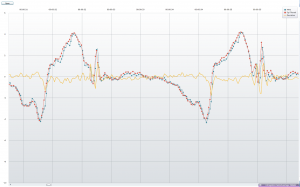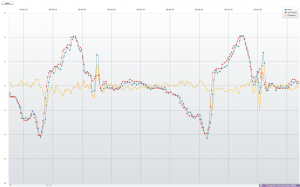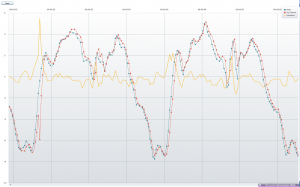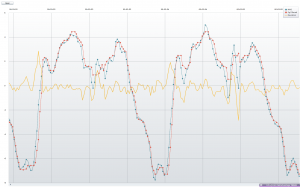RowMotion measurement Validation with FES MMS – Results
As outlined in a previous post we did conduct a reference measurement of RowMotion running on an iPhone 3G and iPhone 4 vs. the FES MMS System. The MMS has been successfully used in professional rowing for more than a decade and results measured with it have been extensively used in scientific publications.
We did record two sessions in a JMA4- with varying stroke frequencies. The iPhones as well as the FES MMS were mounted orthogonal to the boats axis. RowMotion processes acceleration data at 100Hz, while the FES MMS processes them at 49.955Hz, so the RowMotion data has been down-sampled for this comparison. We used linear interpolation between two neighbouring data points of each sampling point to downsample the RowMotion data. The iPhone 3G features a LIS331DL from STMicroelectronics, the iPhone 4 the LIS331DLH of the same vendor. Based on studying Jitter behavior of sensor data delivered through the iOS APIs, it is expected the sensors operate in a mode with a measurement range of +/-4G with a sensitivity of 18mg (milli-g), which is roughly equivalent to 0.18m/s². MMS data was made available at a precision of two digits (1/100 m/s²). The datasets were aligned manually on the x-Axis (time). The full data set is available upon request.
In a first pass we did compare the raw RowMotion data to the MMS but quickly recognized the MMS employed a Lowpass filter on its data, thus making a comparison with raw data unmeaningful. Instead we will show some representative results with lowpass filtered data here at two different stroke rates. As expected, we could not find no difference between iPhone 3G and iPhone 4 acceleration data. For demonstrational purposes, we will omit iPhone4 data in the rest of this post.
This illustration shows MMS data plotted vs. iPhone 3G data. Both datasets have been lowpass filtered. The yellow curve is the deviation between the two signals. We have a very close match between the two curves, with slightly larger deviation after blade extraction, where vibrations strongly affect measurement. It is expected that aliasing effects play a role here, meaning that the high-frequency vibrations are inaccurately reflected in the data.
This illustration shows the same data, but this time the RowMotion signal is using a custom designed data filter to suppress noise on blade extraction. One can clearly that this suppression is quite effective, but we trade some signal fidelity in favor of this noise reduction.
This is a comparison at SF36 with lowpass-filtered data from both systems. Again, we have a very accurate match between the two curves.
This illustration compares MMS data to RowMotion data filtered with our custom filter at SF36.
To summarize the results, we can happily assert that the data provided by RowMotion is on-par with that provided by the MMS System. The signal accuracy is very high and well within the range of what the available sensor hardware can physically deliver. The results indicate that RowMotion data can be safely interpreted with respect to the structure of boat acceleration and also in absolute terms.
The results did also show that the noise suppression employed by RowMotion is very effective but comes at the price of a loss in signal accuracy. With this reference data at hand we are thinking about removing the noise suppression filter in favor of higher signal fidelity. But there are additional concerns, one of those being the interplay with sonification. Vibrations caused during blade extraction have a significant influence on the generated sound and can lead to annoying anomalies in the otherwise relatively steady tone. We could employ a pre-filtering of the data for sonification only but every deviation between the sonified and true signal is a possible source of inaccurate feedback, which we try to avoid as much as possible. On the other hand I have customer feedback indicating that the benefits of a better noise suppression for sonification would by far outweigh the possible inaccuracies.
An aspect that has not been yet looked at is the sampling rate of the two systems. If you take a look at the acceleration curves at SF36, you can see that with 50Hz there’s not a lot of datapoints to draw a curve from. RowMotion features a sampling rate of 100Hz, which provides a much better signal fidelity at high stroke rates.
Based on the results demonstrated above, we conclude that RowMotion is a highly capable performance measurement system for rowers and coaches that provides reliable and highly accurate data.




